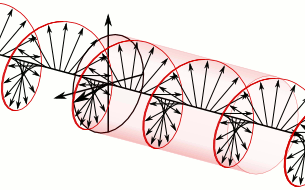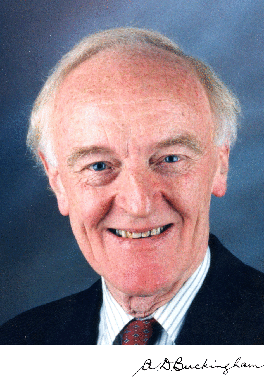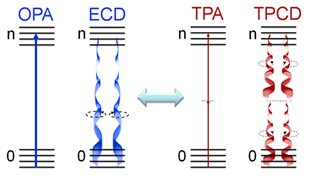
Raman optical activity (ROA) is a vibrational spectroscopic technique that is reliant on the difference in intensity of Raman scattered right and left circularly polarised light due to molecular chirality. [1]

Raman optical activity (ROA) is a vibrational spectroscopic technique that is reliant on the difference in intensity of Raman scattered right and left circularly polarised light due to molecular chirality. [1]
The field began with the doctoral work of Laurence D. Barron with Peter Atkins at the University of Oxford and was later further developed by Barron with David Buckingham at the University of Cambridge.
More developments, including important contributions to the development of practical Raman optical activity instruments, were made by Werner Hug of the University of Fribourg, and Lutz Hecht with Laurence Barron at the University of Glasgow.
The basic principle of Raman optical activity is that there is interference between light waves scattered by the polarizability and optical activity tensors of a chiral molecule, which leads to a difference between the intensities of the right- and left-handed circularly polarised scattered beams. The spectrum of intensity differences recorded over a range of wavenumbers reveals information about chiral centres in the sample molecule.
Raman optical activity can be observed in a number of forms, depending on the polarization of the incident and the scattered light. For instance, in the scattered circular polarization (SCP) experiment, the incident light is linearly polarized and differences in circular polarization of the scattered light are measured. In the dual circular polarization (DCP), both the incident and the scattered light are circularly polarized, either in phase (DCPI ) or out of phase (DCPII ).
Due to its sensitivity to chirality, Raman optical activity is a useful probe of biomolecular structure and behaviour in aqueous solution. It has been used to study protein, nucleic acid, carbohydrate and virus structures. Though the method does not reveal information to the atomic resolution of crystallographic approaches, it is able to examine structure and behaviour in biologically more realistic conditions (compare the dynamic solution structure examined by Raman optical activity to the static crystal structure).
Raman optical activity spectroscopy is related to Raman spectroscopy and circular dichroism. Recent studies have shown how by using optical vortex light beams, a distinct type of Raman optical activity that is sensitive to the orbital angular momentum of the incident light is manifest. [2]
Much of the existing work in the field has utilised custom-made instruments, though commercial instruments are now available.
The symmetry of the neopentane molecule can be broken if some hydrogen atoms are replaced by deuterium atoms. In particular, if each methyl group has a different number of substituted atoms (0, 1, 2, and 3), one obtains a chiral molecule. The chirality in this case arises solely by the mass distribution of its nuclei, while the electron distribution is still essentially achiral. This chirality is the thinnest one synthesized so far and was assessed by ROA in 2007. [3]

Optical rotation, also known as polarization rotation or circular birefringence, is the rotation of the orientation of the plane of polarization about the optical axis of linearly polarized light as it travels through certain materials. Circular birefringence and circular dichroism are the manifestations of optical activity. Optical activity occurs only in chiral materials, those lacking microscopic mirror symmetry. Unlike other sources of birefringence which alter a beam's state of polarization, optical activity can be observed in fluids. This can include gases or solutions of chiral molecules such as sugars, molecules with helical secondary structure such as some proteins, and also chiral liquid crystals. It can also be observed in chiral solids such as certain crystals with a rotation between adjacent crystal planes or metamaterials.

In electrodynamics, circular polarization of an electromagnetic wave is a polarization state in which, at each point, the electromagnetic field of the wave has a constant magnitude and is rotating at a constant rate in a plane perpendicular to the direction of the wave.

Polarization is a property of transverse waves which specifies the geometrical orientation of the oscillations. In a transverse wave, the direction of the oscillation is perpendicular to the direction of motion of the wave. A simple example of a polarized transverse wave is vibrations traveling along a taut string (see image); for example, in a musical instrument like a guitar string. Depending on how the string is plucked, the vibrations can be in a vertical direction, horizontal direction, or at any angle perpendicular to the string. In contrast, in longitudinal waves, such as sound waves in a liquid or gas, the displacement of the particles in the oscillation is always in the direction of propagation, so these waves do not exhibit polarization. Transverse waves that exhibit polarization include electromagnetic waves such as light and radio waves, gravitational waves, and transverse sound waves in solids.

Raman spectroscopy is a spectroscopic technique typically used to determine vibrational modes of molecules, although rotational and other low-frequency modes of systems may also be observed. Raman spectroscopy is commonly used in chemistry to provide a structural fingerprint by which molecules can be identified.
Circular dichroism (CD) is dichroism involving circularly polarized light, i.e., the differential absorption of left- and right-handed light. Left-hand circular (LHC) and right-hand circular (RHC) polarized light represent two possible spin angular momentum states for a photon, and so circular dichroism is also referred to as dichroism for spin angular momentum. This phenomenon was discovered by Jean-Baptiste Biot, Augustin Fresnel, and Aimé Cotton in the first half of the 19th century. Circular dichroism and circular birefringence are manifestations of optical activity. It is exhibited in the absorption bands of optically active chiral molecules. CD spectroscopy has a wide range of applications in many different fields. Most notably, UV CD is used to investigate the secondary structure of proteins. UV/Vis CD is used to investigate charge-transfer transitions. Near-infrared CD is used to investigate geometric and electronic structure by probing metal d→d transitions. Vibrational circular dichroism, which uses light from the infrared energy region, is used for structural studies of small organic molecules, and most recently proteins and DNA.

Raman scattering or the Raman effect is the inelastic scattering of photons by matter, meaning that there is both an exchange of energy and a change in the light's direction. Typically this effect involves vibrational energy being gained by a molecule as incident photons from a visible laser are shifted to lower energy. This is called normal Stokes Raman scattering. The effect is exploited by chemists and physicists to gain information about materials for a variety of purposes by performing various forms of Raman spectroscopy. Many other variants of Raman spectroscopy allow rotational energy to be examined and electronic energy levels may be examined if an X-ray source is used in addition to other possibilities. More complex techniques involving pulsed lasers, multiple laser beams and so on are known.
In Raman spectroscopy, the depolarization ratio is the intensity ratio between the perpendicular component and the parallel component of Raman scattered light.
Resonance Raman spectroscopy is a Raman spectroscopy technique in which the incident photon energy is close in energy to an electronic transition of a compound or material under examination. The frequency coincidence can lead to greatly enhanced intensity of the Raman scattering, which facilitates the study of chemical compounds present at low concentrations.
Planar chirality, also known as 2D chirality, is the special case of chirality for two dimensions.
Optical rotatory dispersion is the variation in the optical rotation of a substance with a change in the wavelength of light. Optical rotatory dispersion can be used to find the absolute configuration of metal complexes. For example, when plane-polarized white light from an overhead projector is passed through a cylinder of sucrose solution, a spiral rainbow is observed perpendicular to the cylinder.

Amyand David Buckingham born in Pymble, Sydney, New South Wales, Australia was a chemist, with primary expertise in chemical physics.
Vibrational circular dichroism (VCD) is a spectroscopic technique which detects differences in attenuation of left and right circularly polarized light passing through a sample. It is the extension of circular dichroism spectroscopy into the infrared and near infrared ranges.
Linear dichroism (LD) or diattenuation is the difference between absorption of light polarized parallel and polarized perpendicular to an orientation axis. It is the property of a material whose transmittance depends on the orientation of linearly polarized light incident upon it. As a technique, it is primarily used to study the functionality and structure of molecules. LD measurements are based on the interaction between matter and light and thus are a form of electromagnetic spectroscopy.

Laurence David Barron has been Gardiner Professor of Chemistry at the University of Glasgow since 1998. He is a chemist who has conducted pioneering research into the properties of chiral molecules — defined by Lord Kelvin as those that cannot be superimposed onto their mirror image. By extending this definition of chirality to include moving particles and processes that vary with time, he has made a fundamental theoretical contribution to the field. Chiral molecules such as amino acids, sugars, proteins, and nucleic acids play a central role in the chemistry of life, and many drug molecules are chiral. Laurence’s work on Raman optical activity — a spectroscopic technique capable of determining the three-dimensional structures of chiral molecules, which he predicted, observed, and applied to problems at the forefront of chemistry and structural biology — has led to its development as a powerful analytical tool used in academic and industrial laboratories worldwide. His much-cited book, Molecular Light Scattering and Optical Activity, has contributed to the growing impact of chirality on many areas of modern science.

The term chiral describes an object, especially a molecule, which has or produces a non-superposable mirror image of itself. In chemistry, such a molecule is called an enantiomer or is said to exhibit chirality or enantiomerism. The term "chiral" comes from the Greek word for the human hand, which itself exhibits such non-superimposeability of the left hand precisely over the right. Due to the opposition of the fingers and thumbs, no matter how the two hands are oriented, it is impossible for both hands to exactly coincide. Helices, chiral characteristics (properties), chiral media, order, and symmetry all relate to the concept of left- and right-handedness.

Chirality is a property of asymmetry important in several branches of science. The word chirality is derived from the Greek χειρ (kheir), "hand", a familiar chiral object.
The following outline is provided as an overview of and topical guide to biophysics:

Two-photon circular dichroism (TPCD), the nonlinear counterpart of electronic circular dichroism (ECD), is defined as the differences between the two-photon absorption (TPA) cross-sections obtained using left circular polarized light and right circular polarized light.
Rotating-polarization coherent anti-Stokes Raman spectroscopy, (RP-CARS) is a particular implementation of the coherent anti-Stokes Raman spectroscopy (CARS). RP-CARS takes advantage of polarization-dependent selection rules in order to gain information about molecule orientation anisotropy and direction within the optical point spread function.

Hyper–Rayleigh scattering Optical Activity, is a nonlinear optical physical effect whereby chiral scatterers convert light to higher frequencies via harmonic generation processes, in a way that the intensity of generated light depends on the chirality of the scatterers. "Hyper–Rayleigh scattering" is a nonlinear optical counterpart to Rayleigh scattering. "Optical activity" refers to any changes in light properties that are due to chirality.